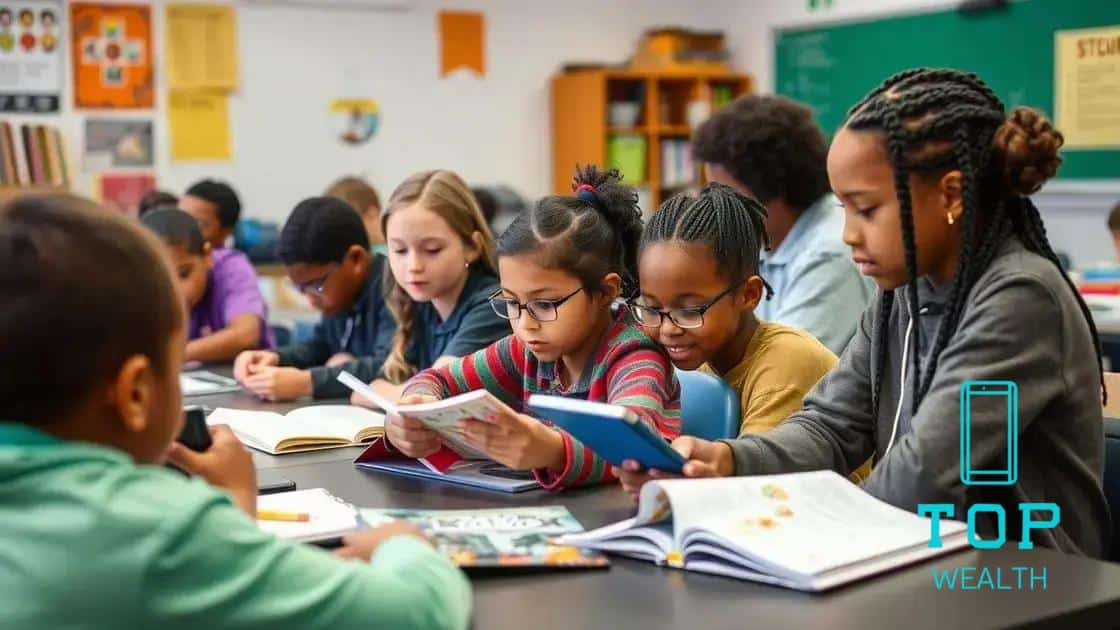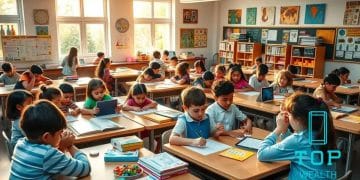K–12 students face unequal access to learning resources

K–12 students face unequal access to learning resources, highlighting the need for community initiatives, funding, and advocacy to create educational equity and provide every student with the necessary tools to succeed.
K–12 students face unequal access to learning resources, and this reality shapes their educational experiences in profound ways. Have you noticed how some students seem to have it easier than others? Let’s dive into the factors at play here.
Understanding the disparities in educational resources
Understanding the disparities in educational resources is crucial to addressing the challenges faced by K–12 students. In many schools across the country, differences in access to necessary tools can greatly affect learning outcomes.
The Impact of Location
One significant factor contributing to these disparities is the geographic location of schools. Schools in affluent areas generally have better funding, allowing them to provide more resources.
- Access to technology such as computers and tablets
- More extracurricular activities and enrichment programs
- Better trained and more experienced teachers
Funding Inequities
Inadequate funding also plays a pivotal role in maintaining equal access. Schools in lower-income neighborhoods often struggle to secure the finances needed for essential supplies and services.
When schools cannot afford basic materials like textbooks and art supplies, it limits students’ learning experiences. This financial inequity creates a cycle where students from disadvantaged backgrounds are less prepared for future academic opportunities.
Consequences of Resource Disparity
The consequences of these disparities are far-reaching. Students with limited access to resources may experience:
- Lower academic achievement
- Increased dropout rates
- Less engagement in learning
These outcomes not only affect students individually but can also have lasting impacts on communities and society as a whole. It’s vital to recognize these inequalities and work towards solutions.
By understanding and addressing the disparities in educational resources, we can make strides toward creating a more equitable education system for all students.
How access to technology affects learning outcomes
Access to technology significantly affects learning outcomes for K–12 students. In today’s digital age, having the right tools can mean the difference between success and struggle in the classroom.
Benefits of Technology in Education
When schools provide students with access to technology, the benefits are clear.
- Enhanced engagement with interactive learning materials
- Immediate access to information and resources
- Opportunities for personalized learning experiences
These tools can transform traditional educational methods into vibrant, interactive learning environments that motivate students.
Gaps in Technology Access
However, not all students have equal access to technological resources. Disparities in access create significant gaps in skills development.
Students without reliable internet or devices may struggle to complete assignments or engage in online learning. This issue becomes even more pressing during remote learning situations, where technology is essential.
- Limited opportunities to collaborate with peers online
- Challenges in accessing educational platforms
- Feelings of isolation and disconnect from school activities
Students lacking these resources often find themselves falling behind their peers, resulting in lower academic achievements and decreased confidence.
Addressing the gaps in access to technology is critical for ensuring that all K–12 students can succeed in their education. By bridging this digital divide, we pave the way for a brighter future for every learner.
The role of funding in education equality
The role of funding in education equality is a vital aspect of ensuring that all K–12 students receive a quality education. When schools are properly funded, they can offer the resources necessary for every student to succeed.
Importance of Adequate Funding
Funding allows schools to provide essential materials and programs that enhance learning. Schools that receive sufficient financial support can afford:
- Updated textbooks and technology
- More teachers and smaller class sizes
- Extracurricular activities that foster student engagement
These components are crucial for creating an engaging educational environment. When students have access to these resources, they tend to perform better academically.
Disparities in Funding Sources
Unfortunately, funding is often uneven, leading to significant disparities among schools. Many districts rely heavily on local property taxes, causing wealthier areas to enjoy better-funded schools.
This financial model perpetuates inequities, as schools in high-poverty areas struggle to meet basic needs. As a result, students in these schools typically have less access to:
- Advanced placement courses
- Quality instructional materials
- Trained specialists in subjects like art and music
The differences in funding can lead to gaps in educational experiences and outcomes. Students with fewer resources may lack the skills essential for higher education or the workforce.
Addressing funding inequalities is crucial to creating a fair educational landscape. By ensuring that every school receives the resources it needs, we can help all K–12 students achieve their full potential.
Community initiatives to bridge the resource gap

Community initiatives play a vital role in bridging the resource gap faced by K–12 students. Many local organizations and groups are stepping in to provide necessary support to schools and families.
Types of Community Initiatives
These initiatives can take many forms, helping to enhance educational resources for students.
- After-school tutoring programs that improve academic performance
- Book drives to ensure access to reading materials
- Technology donation programs that supply computers and access to the internet
Such programs not only provide essential tools but also foster a sense of community engagement and support.
Collaborations with Schools
Partnerships between community organizations and schools are essential. When schools collaborate with local businesses and volunteers, they can access a wider range of resources.
For instance, local businesses can provide funding or materials for special projects. These partnerships help create opportunities for:
- Workshops that teach students valuable skills
- Mentorship programs that connect students with professionals
- Social events that build community spirit and support
By working together, communities can effectively address the educational disparities faced by students in need.
Bridging the resource gap requires a collective effort. It is important for community members to recognize their potential impact. When everyone contributes, they pave the way for a more equitable education system.
Ideas for advocating for equal access to learning resources
Advocating for equal access to learning resources is essential for ensuring that all K–12 students have the support they need. Many organizations and individuals can take steps to make a difference in their communities.
Raise Awareness in the Community
One important way to advocate is by raising awareness about educational disparities. Hosting community events or workshops can help inform others about the challenges faced by students.
- Invite speakers to share personal stories and insights
- Create informative flyers and social media posts
- Engage local media to cover educational issues
These actions can illustrate the real impact of unequal access on students’ lives and motivate others to join the cause.
Collaborate with Local Organizations
Partnering with local organizations can enhance advocacy efforts. Working together allows communities to pool resources and amplify their messages.
Consider these collaborative actions:
- Join forces with non-profits focused on education
- Organize fundraisers to support under-resourced schools
- Establish mentorship programs that connect students with local professionals
These partnerships can create a larger impact than any single effort, fostering a stronger movement towards educational equality.
Another effective advocacy strategy is to contact local representatives. Encourage community members to reach out to their elected officials and express the need for policies that promote equitable education funding.
Advocating for equal access not only benefits current students but also paves the way for a fairer educational system for future generations.
FAQ – Frequently Asked Questions about Equal Access to Learning Resources
Why is equal access to learning resources important for K–12 students?
Equal access ensures that all students can develop the skills and knowledge they need to succeed, regardless of their background.
What role do community initiatives play in bridging the resource gap?
Community initiatives provide essential support, like tutoring, technology donations, and awareness campaigns, to help students in need.
How can individuals advocate for educational equality?
Individuals can advocate by raising awareness, collaborating with organizations, and contacting local representatives to promote policies for equal funding.
What are some examples of successful community programs?
Examples include after-school tutoring programs, book drives, and technology donation efforts that enhance learning opportunities for students.





